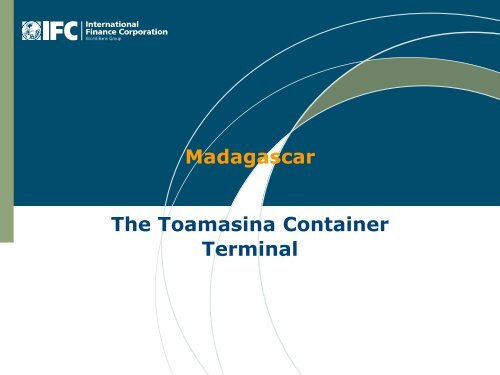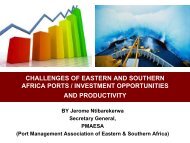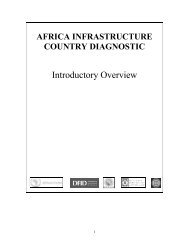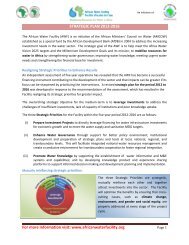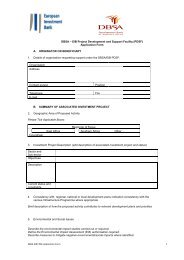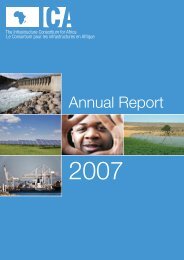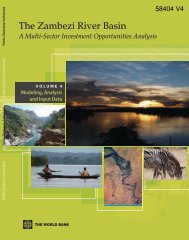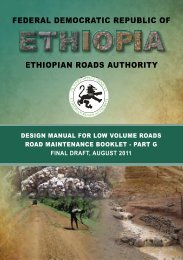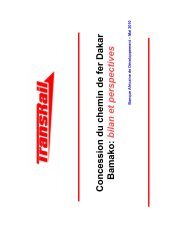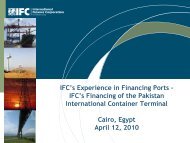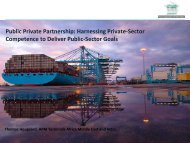madagascar: the toamasina container terminal
madagascar: the toamasina container terminal
madagascar: the toamasina container terminal
You also want an ePaper? Increase the reach of your titles
YUMPU automatically turns print PDFs into web optimized ePapers that Google loves.
Madagascar<br />
The Toamasina Container<br />
Terminal
Toamasina – Map and Location<br />
2
Background<br />
Madagascar:<br />
•New market-oriented government<br />
•Came to power in 2002<br />
•Fully backed by multi and bi-lateral institutions<br />
•Country growth rate of 9.6% in 2003<br />
•Expected growth rates of 6 to 8% p.a. for next 5 years<br />
•Reforms to attract Foreign Direct Investment<br />
•New privatization law and property rights for foreign investors (2004)<br />
•Implementing key reforms in transport sector<br />
•For greater transparency and efficiency
Background<br />
Port of Toamasina<br />
• The principal port of Madagascar<br />
• Accounts for about 80% of all maritime trade and 95% of <strong>container</strong><br />
traffic<br />
• Poor tariff structures<br />
• Slow handling (5-6 TEU per hour)<br />
Containers<br />
• 55-65% of total traffic<br />
• 1992 to 2004: traffic increased from 26,500 TEU to 91,900 TEU<br />
• Low transit (20 days average sitting time)<br />
• Outdated equipment
Background<br />
• GOM mandated IFC as its Principal Advisor to<br />
design, structure and implement a PPP for <strong>the</strong><br />
Container Terminal (CT) of <strong>the</strong> Port of<br />
Toamasina<br />
• GOM’s principal objectives for <strong>the</strong> transaction:<br />
• Improve efficiency and competitiveness of CT<br />
• Implement a PPP in a transparent and competitive manner<br />
• Modify and adapt institutional and regulatory framework<br />
for better transparency and efficiency
6<br />
Key Elements of <strong>the</strong> Transaction Structure<br />
A Careful Balance of KPIs/Output and Investment/Input Obligations<br />
• Key Performance Indicators (Operational and management)<br />
• Container Handling productivity (e.g. 34 mvmts/hour in 2007)<br />
• Berth Occupancy<br />
• Container Yard Delivery productivity<br />
• Theft of Containers<br />
• Damages<br />
• Employees accidents<br />
Investment Obligations:<br />
• Enclosure and access buildings<br />
• Rehabilitation of quay<br />
• Lighting, access roads and o<strong>the</strong>r networks<br />
• Administrative Building<br />
• Rail Interface<br />
• Important penalties in case of non respect and enforcement<br />
mechanisms backed-up by Performance Bond
7<br />
Key Elements of <strong>the</strong> Transaction Structure (Cont’d)<br />
Reinforced by sustainable incentives for all parties:<br />
• 20 years Concession (with “rendez-vous” every 5 years)<br />
• Upfront Tariff reduction: -20% handling and -10% for reception &<br />
delivery<br />
• Obligation to keep 350 employees for 5 years<br />
• Social Fund: Funded by 1% of EBITDA – to fund training and o<strong>the</strong>r<br />
programs for employees<br />
• Concession upfront fee<br />
• includes development costs of <strong>the</strong> project and initial budget of <strong>the</strong><br />
Port Authority<br />
• Purchase of existing equipment<br />
• Yearly Fixed and Variable concession Fees<br />
• Fixed Fee increases in time (from Euro 1 ml to 2,5 ml)<br />
• Variable Fee reduced by 20% once 200,000 TEU/year
Market Response<br />
• 16 Expressions of Interest (November 2004)<br />
• 4 consortia pre-qualified (January 2005)<br />
• Commercial bid (May 2005)<br />
• Four consortia presented offers<br />
• ICTSI<br />
• Maersk A.P. Moeller<br />
• Hutchinson Whampoa Ltd<br />
• Malta Freeport Terminals Ltd<br />
• Concession Award (June 2005)<br />
• Winning bidder: ICTSI<br />
8
9<br />
Since Then…<br />
June 2005: ICTSI Wins Madagascar Port Bidding<br />
October 2005: Contract signing ceremony<br />
Upfront payment (including asset acquisition): €10 million<br />
US$36 million invested in <strong>container</strong> handling equipment since<br />
• Quay strengh<strong>the</strong>ning works<br />
• Gottwald heavy duty mobile crane, model GHMK 6407<br />
• Bromma twin-lift spreader (able to lift two 20ft <strong>container</strong>s<br />
simultaneously with each of <strong>the</strong>se weighing up to 25 tons)<br />
• 4 rubber tyred gantries<br />
• New reach stackers<br />
• 14 new Kalmar <strong>terminal</strong> tractors.<br />
• Major investments made in IT hardware and systems including <strong>the</strong><br />
successful rollout of <strong>the</strong> Navis SPARCS system.
Key Institutional Reforms<br />
Sept 2003 – Sector legislation:<br />
- New Port Law and creation of<br />
Agence Portuaire Maritime et<br />
Fluviale (APMF)<br />
July 2004 – Port of Toamasina:<br />
- Decree for <strong>the</strong> creation of new<br />
landlord Port Authority (Société de<br />
Gestion du Port Autonome de<br />
Toamasina “SPAT”)<br />
- Decree classifying <strong>the</strong> Port as a Port<br />
of National Interest with autonomous<br />
management<br />
- Decree setting forth transition<br />
mechanism and separating<br />
regulation and operation activities<br />
APMF<br />
(National Regulator)<br />
SPAT<br />
(Toamasina Landlord )<br />
New SEPT<br />
(state owned,<br />
non-<strong>container</strong>)<br />
O<strong>the</strong>r private<br />
concessions<br />
Private<br />
Container<br />
Terminal
Transaction Calendar<br />
January 2004 Summer 2004 Fall 2004 Winter 2004-05 Spring 2005 Summer 2005<br />
Diagnostic phase Implementation Phase<br />
Mobilisation<br />
Mobilitsation<br />
IFC team<br />
Due Diligence (legal,<br />
technical, social,<br />
financial,accounting)<br />
Investors due<br />
diligence and<br />
negotiation of<br />
contractual<br />
documents<br />
Closing<br />
EoI<br />
communication<br />
Strategic<br />
options<br />
Prequalification<br />
Launch of bid
In Reforms…<br />
There are winners, losers and fence sitters;<br />
Sometimes winners don’t know <strong>the</strong>y are winners;<br />
Some of those who consider <strong>the</strong>mselves losers don’t know<br />
<strong>the</strong>y are not losers;<br />
All winners & fence sitters need to be mobilized;<br />
Opponents need to be identified;<br />
An overall vision is needed - where to start, where to go and<br />
how.
Communication Issues<br />
• Opposition within SEPT (executive officers) to <strong>the</strong> transfer<br />
of power to <strong>the</strong> new entity to be created by APMF (SPAT);<br />
• Opposition at labor level to labor rationalization, fear of<br />
retrenchments;<br />
• Union opposition to port “privatization”;<br />
• A common mistrust of placing management (and perceived<br />
control) of <strong>the</strong> national port into <strong>the</strong> hands of private—in<br />
particular foreign—hands;<br />
• Ideological holdover from <strong>the</strong> socialist past;<br />
• It is difficult for <strong>the</strong> public to understand <strong>the</strong> potential<br />
financial benefits of an efficient functioning port;<br />
• 5000 households depend on jobs provided by <strong>the</strong> port.
Labor Strategy<br />
SEPT<br />
• 1716 permanent workers<br />
• 1784 daily workers<br />
Container Terminal<br />
• 314 Staff<br />
• 80% >45 yrs old<br />
• 14% retirement age<br />
given relatively low wages and old age of workers:<br />
IFC recommends a conservative approach to ensure social<br />
balance during transition
Local Consultant<br />
• Social Plan,<br />
• stakeholder analysis<br />
Triggers to Communication Intervention<br />
• communication action plan<br />
Government<br />
Inadequate communication approach<br />
• Lack of communication capacity<br />
• Lack of transparency on <strong>the</strong> reform process<br />
Media<br />
• Articles echoing unions’ opposition to “privatization”<br />
JDW’s visit to Madagascar<br />
• He strongly recommends an effective communication campaign before<br />
prequalification process
Potential Impact on Project Success<br />
Stakeholders Prioritization<br />
High<br />
Address<br />
Address<br />
concerns<br />
Concerns<br />
and<br />
and engage Engage<br />
Design ways to engage<br />
Design <strong>the</strong>se individuals ways to engage who don’t <strong>the</strong>se<br />
individuals support <strong>the</strong> who project. don ’ t Help support to<br />
<strong>the</strong><br />
build<br />
project.<br />
ownership,<br />
Help to<br />
increase<br />
build<br />
ownership,<br />
involvement,<br />
increase<br />
and suppress<br />
involvement,<br />
negative notions.<br />
and suppress<br />
negative notions.<br />
Enlist<br />
Enlist<br />
help,<br />
Help,<br />
support<br />
Support<br />
and<br />
and lead Lead<br />
These individuals become <strong>the</strong><br />
champions.<br />
These individuals<br />
They should<br />
become<br />
be<br />
<strong>the</strong><br />
champions . They should be<br />
enlisted to be leaders in<br />
enlisted to be leaders in<br />
communicating key messages.<br />
communicating key messages.<br />
A<br />
A<br />
B<br />
C<br />
D<br />
D<br />
C<br />
Address Concerns concerns<br />
and engage Engage<br />
E<br />
E<br />
G<br />
F<br />
H<br />
I<br />
Enlist help, Help, Support support<br />
and Lead lead<br />
H<br />
Keep Keep Informed<br />
These These individuals need only to<br />
be only kept to abreast be kept of program or<br />
respond abreast to of inquiries program as or<br />
appropriate. respond to inquiries as<br />
appropriate.<br />
Involve as as needed Needed<br />
This group should be<br />
called upon upon as as needed to<br />
rally support.<br />
to<br />
G<br />
Keep informed<br />
Informed<br />
J<br />
F<br />
Involve as Needed<br />
needed<br />
K<br />
Low<br />
Level of Support for Project<br />
High<br />
SEPT<br />
Media<br />
Government Officials<br />
Public<br />
Associations<br />
Local Official<br />
A<br />
– SEPT employees<br />
B – Labor Union<br />
C – Mayor –<br />
D – SEPT executives<br />
E<br />
– Line Ministers<br />
F – Journalists<br />
G – General Public<br />
H – Vice Prime Minister
Targeted communication strategy<br />
Audiences<br />
SEPT Employees<br />
SEPT Executives<br />
Politicians<br />
Journalists<br />
General Public<br />
Objectives<br />
Reassure <strong>the</strong>m that <strong>the</strong>y will not<br />
lose <strong>the</strong>ir jobs and <strong>the</strong>y are<br />
entitled to <strong>the</strong> collective<br />
bargaining benefits<br />
Explain benefits of improved<br />
management by private operator<br />
and possible career<br />
developments<br />
Counter political opposition<br />
within Government by ensuring<br />
support of line Ministers and local<br />
authorities (Mayor)<br />
Ensure good understanding of<br />
PPP process and benefits of<br />
concession<br />
Inform about benefits of reform
Key messages<br />
• Benefits of reform: improve performance and<br />
competitiveness, modernization et development<br />
of Container Terminal (CT)<br />
• Country pride: importance of CT attracting 16<br />
investors<br />
• Golden Rule: “nobody will suffer because of <strong>the</strong><br />
reform” (constantly repeated by VPM)<br />
• Reform milestones and next steps are clarified<br />
and reminded
Immediate Communication Actions<br />
• Establish an Info point in <strong>the</strong> Port premises where a<br />
spokesperson for <strong>the</strong> VPM respond to employees' inquiries<br />
• Report <strong>the</strong> type of inquiries and redesign/update <strong>the</strong> info<br />
material as needed<br />
• Disseminate brochures (Q&A format), and place posters in<br />
<strong>the</strong> port cafeteria, at <strong>the</strong> entry….<br />
• General meeting between SEPT staff and VPM and AD<br />
• Local radio interview with VPM and Manager of SPAT (AD)<br />
• Presentations to <strong>the</strong> Inter Ministerial Committee<br />
• Face to face meetings with local authorities<br />
• Press releases<br />
• 2-3 weeks before prequalification and afterwards<br />
communicate all steps in <strong>the</strong> concession process
Toamasina lessons<br />
• Proactive approach<br />
• Government Communication “supported” by IFC project team<br />
• Clearly assigned communication responsibilities in <strong>the</strong> team<br />
(communication specialist)<br />
• Communication action plan integrated into project timeframe<br />
• Continuous monitoring of communication activities, feedback<br />
and adjustment<br />
• Positive outcome of stakeholders engagement:<br />
• Creation of a monthly stakeholders’ roundtable to discuss<br />
concerns relating to <strong>the</strong> port and its operations
THANK YOU<br />
MERCI


